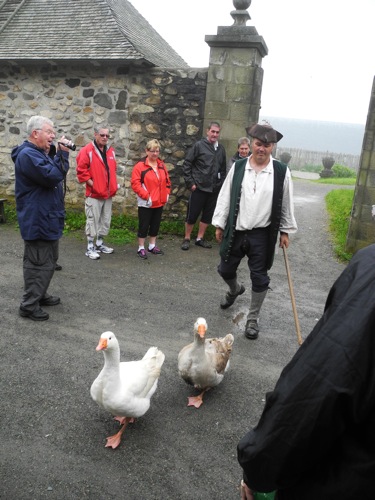
Fortress of Louisbourg National Historic Site
Loyalists and Acadians
We spent the next day at St. Andrews, a charming fishing village near the Maine border that was settled by Loyalists after the Revolutionary War.
“This is 2013, and they are still very Loyalist,” said Lisa.
We took a whale-watching cruise with Quoddy Link Marine and were treated to the sights of a minke whale, one of a dozen species of whales found in the bay; numerous gray seals; porpoises; and hundreds of seabirds nested in the pocked cliffs of White Horse Island.
At the Fundy Discovery Aquarium on our way out of town, we had fun in the touch tank and watching a seal feeding.
We took a ferry across the bay back to Nova Scotia, and after a night in Digby and a meal of its famous scallops, we headed back to Halifax through the Annapolis Valley, “the richest farming area in Nova Scotia.”
This is the land of the Acadians, the French settlers who were forcibly evicted in the mid-1700s by the British. I was aware of the Acadians from my visits to Louisiana, where they were the forerunners of the fascinating Cajun culture, and Longfellow’s poem “Evangeline.” However, our stop at the Grand-Pré National Historic Site expanded my understanding of the human tragedy of their deportation.
A well-produced 22-minute multimedia presentation at the site’s visitors center gives a good background to the removal of the Acadians from the rich land they had wrestled from marshland and sea over generations. Families were often tragically separated and scattered throughout the American Colonies and overseas.
The exhibits in the center include a life-size cross-section of a dike the Acadians built to hold back the sea, dikes that are still in use today.
A statue of Evangeline stands in front of a churchlike structure built in 1930 as a memorial to the Acadians.
Visions of Nova Scotia
Although I thoroughly enjoyed the first week of the trip, it was not what I had imagined Maritime Canada to be. That feeling quickly changed as we headed out the next day.
“Today is probably what you think Nova Scotia looks like,” said Lisa. “The South Shore is what Nova Scotia is supposed to look like.”
As the early morning fog of Halifax dissipated, we saw the effects of the mile-deep glaciers that carved the craggy coastline of the Maritimes.
“It’s quite dramatic when you come around the corner and see the landscape,” said Lisa. “It is barren and Arctic-like.”
We were headed to the fishing village of Peggy’s Cove for breakfast at the Sou’Wester restaurant, with views of the town’s famous red-and-white, 1850s lighthouse sitting atop a jumble of huge granite boulders.
Although only about 35 people live in Peggy’s Cove year-round, it welcomes millions of visitors each year and is possibly the Maritimes’ most famous site. As such, I was worried it wouldn’t live up to expectations. But I worried in vain.
After breakfast, we took a leisurely stroll through the town, listening to a kilt-clad bagpipe busker playing in front of the lighthouse, stopping in shops with hand-crafted items, and examining lobster traps and multicolored marker buoys piled on wharfs next to lobster boats.
Another charming fishing village awaited at our lunch stop. Lunenburg, a UNESCO World Heritage Town, “is a perfect example of a British planned town,” said Lisa. “The streets are laid out as they were in 1753.”
Lisa gave us a walking tour of the town with its multicolored 18th- and 19th-century houses, many of which have the unusual “Lunenburg bump”: double dormers over the front door. The downtown features galleries and locally owned shops; metal representations of fish caught locally hang from the light posts.
After lunch on an outdoor deck overlooking the waterfront, Marcheta and I toured the Fisheries Museum of the Atlantic, which is filled with artifacts and information about the fishing industry. Spread over three floors of a former fish-processing plant, the museum also has two ships on display at the wharf.









